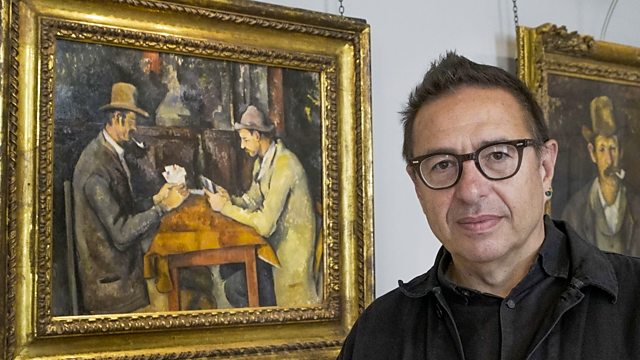The Art Mysteries episode 4: The Card Players is one of Cezanne’s best-known pictures, but it is also one of his most mysterious. Why did the so-called father of modern art paint two old men hunched over a game of cards? What is the picture trying to tell us?
By exploring Cezanne’s puzzling religious beliefs and his passion for Mary Magdalene, the patron saint of Provence, Waldemar Januszczak uncovers the surprising secrets of a haunting masterpiece.
The Art Mysteries episode 4
Paul Cézanne
Paul Cézanne was a French artist and Post-Impressionist painter whose work laid the foundations of the transition from the 19th-century conception of artistic endeavour to a new and radically different world of art in the 20th century.
Cézanne is said to have formed the bridge between late 19th-century Impressionism and the early 20th century’s new line of artistic enquiry, Cubism. Cézanne’s often repetitive, exploratory brushstrokes are highly characteristic and clearly recognizable. He used planes of colour and small brushstrokes that build up to form complex fields. The paintings convey Cézanne’s intense study of his subjects. Both Matisse and Picasso are said to have remarked that Cézanne “is the father of us all”.
Cézanne’s works were rejected numerous times by the official Salon in Paris and ridiculed by art critics when exhibited with the Impressionists. Yet during his lifetime Cézanne was considered a master by younger artists who visited his studio in Aix.
Along with the work of Vincent van Gogh and Paul Gauguin, the work of Cézanne, with its sense of immediacy and incompletion, critically influenced Matisse and others prior to Fauvism and Expressionism. After Cézanne died in 1906, his paintings were exhibited in a large museum-like retrospective in Paris, September 1907. The 1907 Cézanne retrospective at the Salon d’Automne greatly affected the direction that the avant-garde in Paris took, lending credence to his position as one of the most influential artists of the 19th century and to the advent of Cubism.
The Card Players
The Card Players is a series of oil paintings by the French Post-Impressionist artist Paul Cézanne. Painted during Cézanne’s final period in the early 1890s, there are five paintings in the series. The versions vary in size, the number of players, and the setting in which the game takes place. Cézanne also completed numerous drawings and studies in preparation for The Card Players series.
One version of The Card Players was sold in 2011 to the Royal Family of Qatar for a price estimated at $250 million ($287.6 million today), signifying a new mark for highest ever price for a painting, not surpassed until November 2017.
The series is considered by critics to be a cornerstone of Cézanne’s art during the early-to-mid 1890s period, as well as a “prelude” to his final years, when he painted some of his most acclaimed work.
Each painting depicts Provençal peasants immersed in their pipes and playing cards. The subjects, all male, are displayed as studious within their card playing, eyes cast downward, intent on the game at hand. Cézanne adapted a motif from 17th-century Dutch and French genre painting which often depicted card games with rowdy, drunken gamblers in taverns, replacing them instead with stone-faced tradesmen in a more simplified setting.
Whereas previous paintings of the genre had illustrated heightened moments of drama, Cézanne’s portraits have been noted for their lack of drama, narrative, and conventional characterization. Other than an unused wine bottle in the two-player versions, there is an absence of drink and money, which were prominent fixtures of the 17th-century genre. A painting by one of the Le Nain brothers, hung in an Aix-en-Provence museum near the artist’s home, depicts card players and is widely cited as an inspiration for the works by Cézanne.




